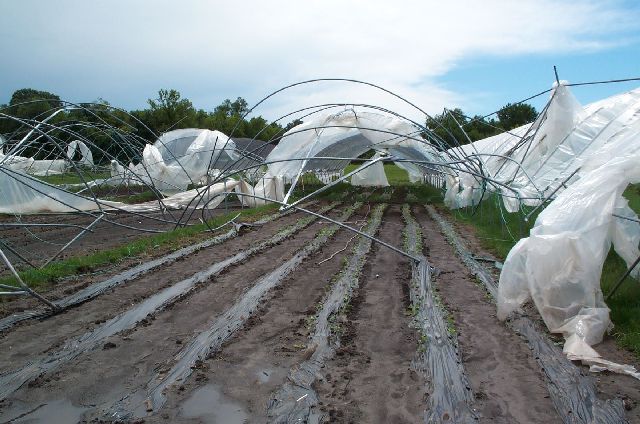Author: Natalie Hoidal, UMN Extension educator, local foods and vegetable crops
This was a rough week. Many of you sustained damage to your farms, including damage to high tunnels and other infrastructure, as well as damaged trees. Heavy rains delayed planting and bed prep yet again, and the cooler weather sustained many of the issues we've been having with humidity in greenhouses. Looking forward, the week ahead looks more calm, though temperatures will remain cool.
Crop updates
- Sweet corn: Growers
in Southern MN can probably begin direct seeding sweet corn this week,
especially if you have varieties suited to cooler soils. Transplanted
corn seems to be doing well so far. The seedcorn maggot forecast predicts that the first generation has emerged already in the southern half of the state. Read more about it here.
- Asparagus: Asparagus harvest is now underway, and asparagus beetles are laying eggs. Eggs are black and usually stick out at a 90 degree angle; they can be along the stem or in the top of the spear. Harvesting spears regularly can help reduce populations since doing so removes eggs from the field. The threshold for spraying is: 1/10 plants have adult beetles, 50-75% of the plants have larvae, or 2% of spears have eggs. Learn more about management options in the Growing Asparagus in Minnesota guide.
- Cole crops: Most people have finally been able to get their Brassicas out into the field. The cabbage maggot forecast shows that adults are already flying in the Southern part of the state, and they should reach central Minnesota this week. I've already seen some flea beetles in Dakota County. Consistent cool weather increases the likelihood of bolting when warm weather finally comes. Brassicas are winter annuals in their home range of the Mediterranean, and they have to go through a vernalization period to trigger flowering. Our cold spring evenings provide this vernalization, and once they are exposed to enough cold, they can enter their reproductive / flowering phase. One of my broccolini varieties at home has already bolted!
Bolting broccoli. Image: ret0dd, Wikimedia
- Tomatoes and peppers: Our return to cool weather and plenty of moisture in the atmosphere this week means growers need to be extra vigilant about increasing airflow in greenhouses / tunnels, and scouting for disease. We've seen plenty of gray mold and bacterial leaf spot already this spring.
- Garlic: Garlic
is catching up quickly, despite a slightly delayed spring. In this month's Premium Garlic Newsletter,
Jerry Ford shared some preliminary results from garlic demonstration
plots at six farms across the state (full results to be published soon).
Here's what they found regarding spring mulch removal:It’s an abiding practice among some garlic growers to remove mulch in the spring to warm up the ground and give the plants a head start. Other growers claim that it doesn’t make a difference, and the reduction in weeding by leaving the mulch on is worth it. In 2018, we had six farms participating, and in 2019 there were five.
We found that it made little difference in the size of the bulbs harvested. In 2018, the un-mulched bulbs were an average of 9% smaller than those where the mulch was left in place; whereas, in 2019, they were 3.4% larger. All the growers reported that they had to weed the un-mulched plots more often. One farm claimed that un-mulched bulbs were harder to clean.
- Carrots and beets: Many growers may have to re-plant after the heavy rains last week. Keep an eye on your soil to prevent crusting, which can happen after heavy rainfall events. Providing light irrigation to keep the top half centimeter of soil consistently moist can help to prevent crusting in fields where you're waiting for small seeded crops to germinate.
Vegetable weather report
Soil temperatures from MDA stations, data collected to 6’’ depth
|
Station location |
Nearest major town |
Coldest soil temperature in the last 7 days (approx.) |
Temperature on May 17, 2020 (approx). |
|
Blue Earth |
Albert Lea (Iowa border) |
56 º F |
61 º F |
|
Russel |
Marshall |
58 º F |
68 º F |
|
Henderson |
St. Peter / Belle Plaine |
58 º F |
62 º F |
|
Hoffman |
Alexandria |
48 º F |
51 º F |
Soil temperatures from ND-managed stations in MN
|
Station location |
Nearest major town |
Approximate turf soil temp on May 17 (4’’) |
|
Sabin |
Fargo / Moorhead |
54 º F |
|
Mavie |
Thief River Falls |
50 º F |
|
Fox |
Roseau (Canada border) |
50 º F |
Problems in the field
Tunnel trouble
 |
Tunnel damage after storms. Photo credit: Ted Carey, Kansas State University via eOrganic. |
Think twice about fertility as you prep your fields
- Tunnel Trouble: increasing many things, but not yield
- Where phosphorus comes from and where it goes
- Building organic matter without building phosphorus



Comments
Post a Comment